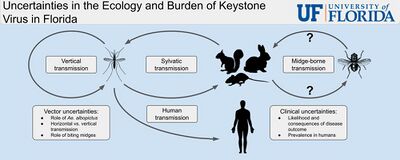Keystone virus
| Keystone orthobunyavirus | |
|---|---|
| Virus classification | |
| (unranked): | Virus |
| Realm: | Riboviria |
| Kingdom: | Orthornavirae |
| Phylum: | Negarnaviricota |
| Class: | Ellioviricetes |
| Order: | Bunyavirales |
| Family: | Peribunyaviridae |
| Genus: | Orthobunyavirus |
| Species: | Keystone orthobunyavirus
|
Keystone virus (Keystone orthobunyavirus)[1] is a mosquito-borne virus which can infect mammals. It was first discovered in animals in the Florida area, where it is spread in part by local species of Aedes mosquitoes. In 1964, a case of human infection, producing minor symptoms of a rash and fever, was circumstantially diagnosed.[2] Conclusive laboratory demonstration of the virus in humans was first obtained and reported in 2018.[3]
Virology

The Keystone virus was first discovered in mosquitoes in the Keystone area of Tampa, Florida in 1964, based on antigenic evidence from specimens caught in 1963.[4] The virus has been subsequently observed along the eastern and southern coastline of the United States, from Boston through Texas.[5] In small mammals it can produce symptoms of encephalitis. Infection in humans is believed to be widespread, based on a 1972 report detecting Keystone virus antibodies in 19–21 percent of the people tested in the Tampa Bay region.[6][7]
The first laboratory isolation of the virus from a human case occurred in Florida in 2016, and was reported in 2018.[8] Identification took almost two years after the case actually occurred, when blood samples taken from the subject in 2016 were analyzed retrospectively by researchers studying the incidence of Zika virus in the Florida population.
The Aedes atlanticus mosquito is a demonstrated vector. The virus transmits transstadially through the different stages of the insect's life: A female mosquito may lay eggs carrying the virus, which hatch into infected larvae, eventually maturing into adults that can infect mammals while injecting their anti-coagulant saliva during a bite.[9]
References
- ↑ "Virus Taxonomy: 2020 Release". International Committee on Taxonomy of Viruses (ICTV). March 2021. Archived from the original on 20 March 2020. Retrieved 25 May 2021.
- ↑ http://www.floridahealth.gov/diseases-and-conditions/disease-reporting-and-management/disease-reporting-and-surveillance/_documents/mosquito-guide-2013.pdf Archived 2017-02-06 at the Wayback Machine Surveillance and Control of Selected Mosquito-borne Diseases in Florida — 2013
"The only recorded human case of Keystone virus illness occurred in a young child from Sarasota in 1964." - ↑ Ashley May: "Keystone virus makes first jump from mosquitoes to humans with confirmed case in Florida teen, study says," https://www.usatoday.com/story/news/nation-now/2018/06/22/first-report-human-keystone-virus-found-florida-teen/725460002/ Archived 2023-02-02 at the Wayback Machine, updated 1:20 p.m. ET June 25, 2018; "Authors said this was the first case of the virus in humans, but the Florida Department of Health told USA TODAY that a young child from Sarasota had the virus in 1964."
- ↑ http://aem.asm.org/content/19/4/557.full.pdf Arbovirus Identification by an Agar-Gel Diffusion Technique
- ↑ "The Ecology and Behavior of Aedes atlanticus D. & K. and Other Species with Reference to Keystone Virus in the Houston Area, Texas". Archived from the original on 2021-08-22. Retrieved 2023-01-30.
- ↑ F. M. Wellings (1972). "Agents Encountered during Arboviral Ecological Studies: Tampa Bay Area, Florida, 1963 to 1970". The American Journal of Tropical Medicine and Hygiene. 21 (2): 201–213. doi:10.4269/ajtmh.1972.21.201. PMID 4400812.
- ↑ Evan Barton (June 18, 2018). "Virus found in Florida resident may be widespread throughout the Southeast". University of Florida Health, Emerging Pathogens Institute. Archived from the original on June 22, 2018. Retrieved June 22, 2018.
- ↑ John A Lednicky; et al. (June 9, 2018). "Keystone Virus Isolated from a Florida Teenager with Rash and Subjective Fever: Another Endemic Arbovirus in the Southeastern United States?". Clinical Infectious Diseases. 68 (1): 143–145. doi:10.1093/cid/ciy485. PMID 29893806.
- ↑ LeDuc JW, Burger JF, Eldridge BF, Russell PK (1975). "Ecology of Keystone virus, a transovarially maintained arbovirus". Ann N Y Acad Sci. 266 (1 Pathobiology): 144–51. Bibcode:1975NYASA.266..144L. doi:10.1111/j.1749-6632.1975.tb35095.x. PMID 20017. S2CID 39831398.
{{cite journal}}: CS1 maint: multiple names: authors list (link)